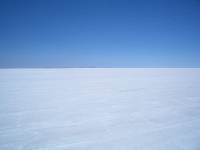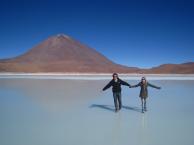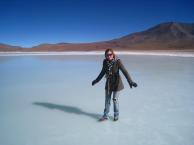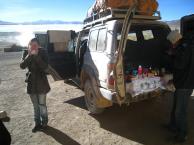Profile
Blog
Photos
Videos
Apologies for the clunkiness of this blog entry. It is some time since we have been in Salar de Uyuni and I fear some of the finer details may have been lost to the nether regions of my grey matter, never to be retrieved.
The bus ride from La Paz to Salar de Uyuni was an experience in itself. We had high expectations of the bus ride, partly due to testimonies of fellow travels and partly because of the price of the ticket, however we were in for a bit of a surprise. The ride was 12 hours or so, overnight. Em and I woke up as daylight broke and immediately started to wonder how on earth we had slept through the night. The bus was vibrating violently, due to the coarseness of the road I suppose, I can't imagine when the road was last grated, if ever. Em commented to me that may naive consumers pay big dollars for fitness machines that provided the kind of vibration of ones' 'wobbly bits' that we had the pleasure of enduring for hours on end.
Em and I had thrown caution to the wind and decided that we would book our Salar de Uyuni tour, which is three days and two nights out in the salt flats, once we arrived in Uyuni - an attempt to bypass the higher prices set by tourist agencies in La Paz. Luckily we had met a lovely dutch couple, Sander and Christy, and organised to jump in with their prebooked tour, which had some space remaining. In our 'Jeep' we had the two Dutchies, two Frenchies (Laura and Alexis), Em, myself and Fastino, our wonderful guide.
The tour company was called Kantuta, they were absolutely terrific, mostly because our guide, Fastino, was just such a lovely guy, and a fabulous cook, he made our tour ever so pleasant - I couldn't recommend him enough. We paid $180 USD from Uyuni for this tour, plus $5 USD for a sleeping bag (but if your thinking of this trip I would suggest bringing your own if at all practically possible, you will be thankful for the warmth of the down feathers).
The bus arrived at 6am and we were in the Jeep by 10am heading into the heart of the salts flats of Uyuni, the only detour on route was to see a train cemetery where 100 years of Bolivian railway hardware is rusting under the sun's rays, from there we made a beeline for the heart of the salt flats.
The salt flats occupy 11,000 square kilometers of the Oruro and Potosi states of southern Bolivia. For comparison, the total area of greater Melbourne is thought to be about 8,500 square kilometers. Needless to say it is a big expanse. When you have driven for an hour or so towards the heart of the salt flats you become immersed in a world of bleached whiteness. Nothing as far as the eye can see distinguishes itself from the bleached nothingness of the salt flat. Its surreal.
That is not to say that there is nothing to see. In fact what there is too see, other than the salt flat itself, sneaks up on you before you can appreciate it. Illusions, that stymie your perception of size and distance, are caused by some sort of combination of the cold air temperature, the altitude and the high reflectivity of the salt flat to produce an illusion-like-haze somewhat similar to a mirage you might see on a hot summers day when you look down a long bitumen expanse in Australia. Anyway, thanks to Fastino we managed to see many of the attractions within the salt flat, which include:
- Pools of bubbling water, that were coloured red, black, turquoise and orange, by various minerals from beneath the salt flat
- A cactus island in the middle of the salt flat, that no doubt gives some refuge for the plants and animals from the vastness and lifelessness of the salt flats.
Our first night was spent on the far side of the salt flat at a small guesthouse. This guesthouse was made entirely from salt, the floor was a pebbly rock salt base, our bed base was made of salt, the tables and chairs made from salt, and so on and so forth. The salt guesthouse though, was an excellent refuge from the cold outside, it got about down to about -10°C on our first night, much less inside probably closer to -2°C. Before a lovely meal, prepared by Fastino, that we all enjoyed on our table and chairs made of salt, we watch the sunset from the middle of the salt flat, a beautiful but freezing experience. We rested our heads that night, all hoping that it didn't rain in the night as these salt houses actually dissolve in rain. (As you could imagine it doesn't happen often, but when it does all the locals get seriously upset. Brings a new meaning to the dissolving of one's assets).
Fastino woke us early on our first morning in Salar de Uyuni to experience a beautiful sunrise while we nestled close over steaming cups of tea and feed our faces with toast for our morning sustenance. Our second day we pushed past the salt flat to explore the delights that lay beyond, in this geographically and geologically enthralling part of the world. Day two visits included stops at:
- Lava rocks formed by a volcano that now lies dormant in the region.
- Laguna Colorada which is a red lagoon that has floating 'icebergs' of bromide.
- Laguna Verde which is a green/turquoise lagoon situated beneath a perfect shaped snow-peeked volcano. Home to a populous flock of flamingos.
- Rock tree, (our photos should tell the story with this one).
- Meteor volcano, an extinct volcano was struck by an enormous meteor somewhere in the earth's distant history, the impact was severe enough to blow a massive hole in the side of the immense volcano. The impact crater to the mountain is of the scale of a big bite out of an apple.
- Wildlife spotting, flamingos, condors, eagles, llama, deer, so on and so forth.
On our second night we were staying at 4400m, and this is when the cold temperatures got really serious. This night got to as low as -20°C. To combat the cold Em and I again piled into one single bed, both of us in our own sleeping bag and one woolen blanket below us to warm us from below and the remaining 4 blankets on top of our sleeping bags, add to this the fact that we were both wearing our long thermals, pajamas, fleece jumpers, beanies, gloves and you start to get the idea of just how cold this ply wood guesthouse got (our own fault I suppose for coming in their winter). Even our fellow French travellers, Laura and Alexis (just friends, not a couple), bunked up to battle the cold. Before the operation of getting into bed, which was a lengthy one, Em and I spent as long as our bodies could muster (10 - 15 minutes) outside starring at the stars above our heads. A starlight display like we had that night is a remarkably beautiful sight, I guess we had the cloudless night, the altitude and the remoteness to thank for the unspoiled light show.
Fastino woke us all at 4am the next morning ready to repack and head out into the -18°C morning air. We arose this early to get to our next destination, the geysers of Salar de Uyuni, in time to watch the sunrise through the eerie-misty morning setting. This was yet another hallucinogenic experience. We stood (albeit violently shivering) by scolding hot boiling mud pools, whilst geysers vented their steam as we took in the colour of the sunrise in the sky and as it reflected off the barren but colourful dormant volcanoes. It was all too much really. As the sun got higher and the colours paled we started to notice the loss of feeling/numbness from the severe cold creep its way from our fingers and toes up our limbs and all six of us thought it best to move onto the next, and final visit for our Salar de Uyuni tour, the thermal springs!
When we got to the thermal spring, we were all itching to get down to the waters edge and lower ourselves into the invigorating warmth. But as we arrived and sampled the temperature of the water, we all reneged, as the air temperature was still about -5°C and the payoffs of getting changed outside and having to get dry wasn't worth the frost bite we all thought, all except Emily. Once into her 'kini' and in the water Emily worked to convince us all to get in. I'm not sure whether it was the sincerity in her voice or the look of relief on her face, but we all followed in and once in it was clear the right choice was made. The 38°C water worked to warm the now seriously cold extremities and alleviated three days of growing numbness. The air temperature was still below freezing though as the my hair was freezing if I left it our of the water for a minute or so. Despite the air temperature, it was so pleasant sitting in the springs that we almost lingered a little too long and missed our connection over the Bolivian-Chilean border. But as always Fastino came to the rescue and got us to our destination with a minute to spare.
Our drop of point was San Pedro de Atacama, Chile, which is the entrance point to Salar de Uyuni from the Chilean side of the border. The two countries share some of this surreal terrain, although most of it resides on the Bolivian side of the border. Our time line was so tight to get to Santiago to catch our flight to London, that despite San Pedro de Atacama's character we didn't stay any longer than an afternoon. We streamlined via Turbus to Santiago, a 24 hour bus ride due South down the coast.
So that was Salar de Uyuni. If any of our millions of readers out there are considering South America as a travel destination I strongly suggest that Salar de Uyuni goes on top of the must not miss list, alongside (but above if you ask me) Machu Picchu, Buenos Aires and Rio de Janeiro.I will write once more from this great continent in Santiago, Chile's capital.
- comments










